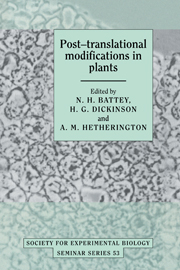Book contents
- Frontmatter
- Contents
- List of contributors
- List of abbreviations
- Preface
- Some roles of post-translational modifications in plants
- Signal transduction and protein phosphorylation in bacteria
- Roles of protein phosphorylation in animal cells
- The significance of post-translational modification of proteins by phosphorylation in the regulation of plant development and metabolism
- Post-translational modification of chloroplast proteins and the regulation of protein turnover
- Purification of a small phosphoprotein from chloroplasts and characterisation of its phosphoryl group
- Use of synthetic peptides to study G proteins and protein kinases within plant cells
- Activation of membrane-associated protein kinase by lipids, its substrates, and its function in signal transduction
- Distribution and function of Ca2+-dependent, calmodulin-independent protein kinases
- Phosphorylation of the plasma membrane proton pump
- The regulation of phosphoenolpyruvate carboxylase by reversible phosphorylation
- Protein phosphorylation and circadian rhythms
- Control of translation by phosphorylation of mRNP proteins in Fucus and Xenopus
- Regulation of plant metabolism by reversible protein (serine/threonine) phosphorylation
- Detection, biosynthesis and some functions of glycans N-linked to plant secreted proteins
- Biosynthesis, intracellular transport and processing of ricin
- Post-translational processing of concanavalin A
- The role of cell surface glycoproteins in differentiation and morphogenesis
- Ubiquitination of proteins during floral development and senescence
- Index
Distribution and function of Ca2+-dependent, calmodulin-independent protein kinases
Published online by Cambridge University Press: 06 July 2010
- Frontmatter
- Contents
- List of contributors
- List of abbreviations
- Preface
- Some roles of post-translational modifications in plants
- Signal transduction and protein phosphorylation in bacteria
- Roles of protein phosphorylation in animal cells
- The significance of post-translational modification of proteins by phosphorylation in the regulation of plant development and metabolism
- Post-translational modification of chloroplast proteins and the regulation of protein turnover
- Purification of a small phosphoprotein from chloroplasts and characterisation of its phosphoryl group
- Use of synthetic peptides to study G proteins and protein kinases within plant cells
- Activation of membrane-associated protein kinase by lipids, its substrates, and its function in signal transduction
- Distribution and function of Ca2+-dependent, calmodulin-independent protein kinases
- Phosphorylation of the plasma membrane proton pump
- The regulation of phosphoenolpyruvate carboxylase by reversible phosphorylation
- Protein phosphorylation and circadian rhythms
- Control of translation by phosphorylation of mRNP proteins in Fucus and Xenopus
- Regulation of plant metabolism by reversible protein (serine/threonine) phosphorylation
- Detection, biosynthesis and some functions of glycans N-linked to plant secreted proteins
- Biosynthesis, intracellular transport and processing of ricin
- Post-translational processing of concanavalin A
- The role of cell surface glycoproteins in differentiation and morphogenesis
- Ubiquitination of proteins during floral development and senescence
- Index
Summary
Review of previous work
Background to plant Ca2+-dependent, calmodulin-independent protein kinases (CPKs)
A brief review of Ca2+-regulated protein kinases in plants is useful because it places in context the smaller group of CPKs we are concerned with here. It also demonstrates that there is now considerable descriptive information available for CPKs, but that this precedes a clear understanding of their function(s) in plant cells.
By the beginning of the 1980s, researchers working on signal transduction in animals had described two main types of protein kinases, whose activity was controlled by cAMP and Ca2+/calmodulin (Cohen, 1982). Therefore the first papers describing Ca2+-regulated protein kinases from plants looked with particular interest for a role for calmodulin (Hetherington & Trewavas, 1982; Polya & Davies, 1982). During this time the evidence was accumulating for protein kinase C in animal cells (Takai et al., 1977, 1979; Nishizuka, 1984). There then followed several papers in which the focus of interest was the role of phospholipid and diacylglycerol in controlling Ca2+-dependent protein kinase activity in plant cells (Schäfer et al., 1985; Muto & Shimogawara, 1985; Elliott & Skinner, 1986). However, there were anomalies in the work so far described; for example, the relatively high concentrations of calmodulin needed for activation effects, and interaction of calmodulin with the histone substrate (see Polya et al., 1990, for discussion); and the general absence of phorbol ester effects on putative protein kinase C activities in plant cells (see Hetherington, Battey & Millner, 1990).
- Type
- Chapter
- Information
- Post-translational Modifications in Plants , pp. 123 - 148Publisher: Cambridge University PressPrint publication year: 1993



